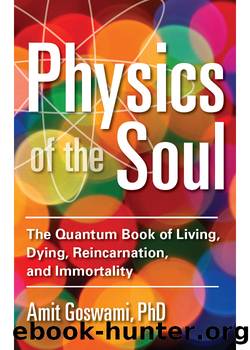Physics of the Soul by Amit Goswami

Author:Amit Goswami
Language: eng
Format: epub
ISBN: 9781612833248
Publisher: Hampton Roads Publishing
8.
The Complete Story of the Tibetan Book of the Dead
It took me a couple of years to intuit, comprehend, and manifest the ideas put forward in the preceding pages. In the beginning months of 1996, I was well into writing the first draft of this book when I noticed that something was still bothering me. You know the phrase “when the shoe fits.” Well, in the case of this work, the shoe fit, but there seemed to be some irritating sand still in the shoe.
Gradually, I began to recognize what the thorny issues were. I intuited the idea of the nonlocal window through which sometimes reincarnational-content memories break through before I intuited the quantum monad. Being lazy, I was assuming that the two ideas just complement one another—one for content memory, one for the reincarnational propagation of context memory—and there was no need to further integrate them. I was wrong.
The pointers were there, but I was refusing to see them. In chapter 4, I proposed that all the Tibetan Book of the Dead after-death bardos were nonlocal visions of the dying person at death. But now, with the idea of the quantum monad, it is possible to define individual existence after death—we exist as discarnate quantum monads. Shouldn't the after-death bardos logically pertain to the quantum monad then? So the logic is inescapable: the nonlocal window opens before death, in the third bardo of transition from life to death.
Another hint came from the near-death experiences that supported my scenario—nonlocal experiences, archetypal visions, panoramic life-review experiences, and all that. But there are also differences between those and the after-death bardos: NDErs seldom report hell realms or wrathful Gods. They also do not usually report establishing rapport and communication with their future incarnations. And also, the undeniable fact is that the near-death experiences are just that—they are experiences of events before actual death.
As a scientist, I have a habit that is both good and bad. During the time I am working on an original idea, I don't like reading too many of other people's ideas. This saves me from becoming prematurely prejudiced or influenced. The bad side is that I miss the opportunity of seeing further “by standing on the shoulders of giants,” so to speak.
It turned out that the famous Evans-Wentz translation of the Tibetan Book of the Dead that I took as my source omitted the pre-death stages which are part and parcel of the death scenario that originated with the famous Padmasambhaba, the founder of Tibetan Buddhism. As I was reading Ken Wilber's article in the wonderful compilation What Survives? the final pieces of the story came together (Wilber 1990). This final synthesis is the main subject of this chapter which we will delve into after an in-depth discussion on the subject of death and dying.
One final, face-saving comment: The near-death experiences have such commonalities with the description of the after-death bardos that even a sage as wise as Sogyal Rinpoche was tempted to associate the two (read his book, the Tibetan Book of Living and Dying).
Download
This site does not store any files on its server. We only index and link to content provided by other sites. Please contact the content providers to delete copyright contents if any and email us, we'll remove relevant links or contents immediately.
The History of Jihad: From Muhammad to ISIS by Spencer Robert(2575)
Nine Parts of Desire by Geraldine Brooks(2328)
The Turkish Psychedelic Explosion by Daniel Spicer(2314)
The First Muslim The Story of Muhammad by Lesley Hazleton(2222)
The Essential Rumi by Coleman Barks(1992)
1453 by Roger Crowley(1974)
The Last Mughal by William Dalrymple(1834)
Trickster Travels: A Sixteenth-Century Muslim Between Worlds by Davis Natalie Zemon(1815)
God by Aslan Reza(1616)
Muhammad: His Life Based on the Earliest Sources by Martin Lings(1608)
by Christianity & Islam(1596)
A Concise History of Sunnis and Shi'is by John McHugo(1547)
Magic and Divination in Early Islam by Emilie Savage-Smith;(1501)
No God But God by Reza Aslan(1500)
The Flight of the Intellectuals by Berman Paul(1466)
Art of Betrayal by Gordon Corera(1403)
Nothing to Envy by Barbara Demick(1389)
What the Qur'an Meant by Garry Wills(1363)
Getting Jesus Right: How Muslims Get Jesus and Islam Wrong by James A Beverley & Craig A Evans(1312)
